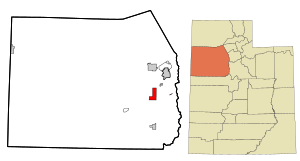Rush Valley, Utah facts for kids
Quick facts for kids
Rush Valley, Utah
|
|
|---|---|

Location in Tooele County and the state of Utah
|
|

Location of Utah in the United States
|
|
| Country | United States |
| State | Utah |
| County | Tooele |
| Settled | 1856 |
| Incorporated (Onaqui) | 1934 |
| Incorporated (Rush Valley) | February 22, 1972 |
| Named for | Rush Lake |
| Area | |
| • Total | 18.08 sq mi (46.83 km2) |
| • Land | 18.08 sq mi (46.83 km2) |
| • Water | 0.00 sq mi (0.00 km2) |
| Elevation | 5,046 ft (1,538 m) |
| Population
(2010)
|
|
| • Total | 447 |
| • Estimate
(2019)
|
494 |
| • Density | 27.32/sq mi (10.55/km2) |
| Time zone | UTC-7 (Mountain (MST)) |
| • Summer (DST) | UTC-6 (MDT) |
| ZIP code |
84069
|
| Area code(s) | 435 |
| FIPS code | 49-65240 |
| GNIS feature ID | 2412585 |
Rush Valley is a small town in Tooele County, Utah, in the United States. It's located in the northwest part of the larger Rush Valley area. This town is also part of the bigger Salt Lake City metropolitan area. In 2010, about 447 people lived there.
Contents
Where is Rush Valley?
Rush Valley covers an area of about 18.3 square miles (47.5 square kilometers). All of this land is dry land, with no large bodies of water inside the town limits.
What is the Climate Like?
The weather in Rush Valley is known as a semi-arid climate. This means it's usually dry, but not a complete desert. It gets some rain, but not a lot.
A Brief History of Rush Valley
People first started settling in this area in 1856. Later, in 1934, a big area of about 33 square miles became one town. This new town was called Onaqui. It included the smaller settlements of Clover, St. John, and Vernon.
The main reason for creating Onaqui was to get help from the government. They wanted federal aid to build important things like roads and power lines. This included help from the Rural Electrification Administration, which brought electricity to many rural areas.
On February 22, 1972, the people of Vernon decided they wanted their own separate town. So, Vernon became its own town. The rest of Onaqui was then renamed Rush Valley.
Who Lives in Rush Valley?
| Historical population | |||
|---|---|---|---|
| Census | Pop. | %± | |
| 1940 | 374 | — | |
| 1950 | 333 | −11.0% | |
| 1960 | 511 | 53.5% | |
| 1970 | 541 | 5.9% | |
| 1980 | 356 | −34.2% | |
| 1990 | 339 | −4.8% | |
| 2000 | 453 | 33.6% | |
| 2010 | 447 | −1.3% | |
| 2019 (est.) | 494 | 10.5% | |
| U.S. Decennial Census | |||
In 2000, there were 453 people living in Rush Valley. These people lived in 149 households, and 123 of these were families. The town had about 24.7 people per square mile. Most of the people (98.01%) were White. A small number were Native American, Pacific Islander, or from other backgrounds. About 1.10% of the population was Hispanic or Latino.
Households and Families
Out of the 149 households, about 34.9% had children under 18 living there. Most households (71.8%) were married couples living together. About 7.4% had a female head of household with no husband. Around 16.8% were not families. The average household had about 3.04 people, and the average family had 3.34 people.
Age and Income
The population in Rush Valley was spread out by age. About 26.9% were under 18 years old. The median age, which is the middle age of all the people, was 38 years.
The median income for a household in the town was $46,875. For families, the median income was $48,036. This means half of the households earned more than this amount, and half earned less. The average income per person in the town was $14,661. About 10.4% of all people in Rush Valley lived below the poverty line. This included 15.4% of those under 18.
See also

- In Spanish: Rush Valley para niños

